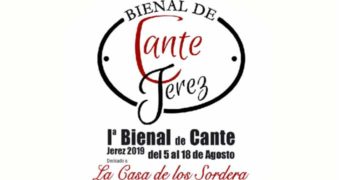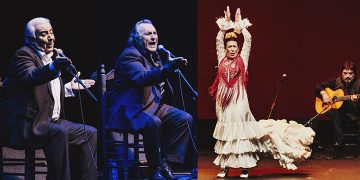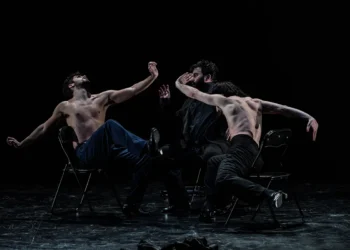|
Rafael Amargo “Tiempo Muerto” |
|
Texto: Estela Zatania The sixth day at the Festival de Jerez got underway at the Sala la Compañía with the performance of Ángel Berna and his work “Rasmia” with the series titled “Con Nombre Propio”. Berna, from Zaragoza, has raised the art of the regional dance known as “jota” to new heights, and some people are calling it “jota flamenca”. With transparent castanets of metacrylate, he won over the audience with a combination of jota, flamenco and modern dance. Rafael Amargo “Tiempo Muerto” Dance: Rafael Amargo, Susi Parra, Vanesa Gálvez, Eli Ayala, Carmen Iglesias, Rosana Romero. Cante: Maite Maya, Carmina Cortés, Pedro Obregón. Guitar: Flavio Rodrígues, Eduardo Cortés. Flute: Juan Parrilla. Violin: David Moreira. Violoncello: Mikel Zunzundegui. Piano: Jato. Cajón: Antonio Maya. Special guest artist: María la Coneja, Sorderita.
The main show of the day’s program was the large-scale work titled “Tiempo Muerto” by Rafael Amargo, and we’ve got much to say about this man, if only because he is one of those few “chosen” ones who have numerous detractors, although the undersigned has never understood why. “Tiempo Muerto” is an uneven work, with some unpresentable passages, based on murky concepts you suspect are very important to their author but which you can’t quite sort out. In other words, it’s no different from 99% of other flamenco dance works presented throughout the world, applauded and hailed as the products of genius. So let’s speak about Rafael Amargo. Granada’s flamenco people, and in general, all those from eastern Andalucía, have an essentially different concept of flamenco compared to the western part of the region. They don’t seem to suffer from the syndrome of “cante zone”, “the golden triangle” or “flamenco dynasty”. In Granada flamenco is a means to an end, an aesthetic based on certain forms that may lead to a worthwhile or enjoyable outcome, be it high art or popular manifestation, always in line with the aesthetic, an aroma that attracts us as surely and irresistibly as the smell of good food. You go to an informal fiesta in Granada, and people are singing and keeping compás no sooner than walking through the door. No hang-ups. It’s a kind of innocent enthusiasm that borders on unseemly, diametrically opposed to the dark guarded atmosphere so typical of the “cante zone”. This is what I see in Rafael Amargo, and what I admire in his artistic personality. That’s not to say his product lacks quality. Miscalculation is the privilege of people who take chances, and the artist who takes no risks, who holds back or tries to pass off coldness as “sophistication”, is not even worthy of consideration. Rafael Amargo is an excellent, inspired dancer. Some day I’d like to see him without the circus he surrounds himself with in order to be able to savour his extraordinary talent. His creativity is his worst enemy. He’s got too many ideas, and like a small child, he comes running to us with his hands full shouting “look at this!” The long number of the hooded women in black, the excess of sledge-hammer percussion, the two women dancers who face off in a footwork duel and an overall feel of Las Vegas, are just a few of the forgettable elements in this complicated work. But in his own dancing, Amargo has flamenco sensitivity. He doesn’t resort to tiresome footwork displays to demonstrate his ease with the compás, he moves with the grace of the best traditional amateurs we so often delight in, while cultivating the sophisticated line of Antonio Gades, he surprises again and again with small details, has a high technical level, and always he is glancing back over his shoulder to take a reading of the essence of flamenco. Rafael Amargo does for flamenco what Antonio Márquez does for Spanish dance: he delivers his sincere, loving vision caring little for critiques like this one you are reading, because he believes in what he does. The show is enriched by interesting collaborations such as those of José Soto “Sorderita”, Juan Parrilla on flute and María la Coneja singing, dancing and flamencoing Sacromonte-style. Calixto Sánchez Mentally exhausted from the show at the Villamarta, the peace and silence of the old Bodega Los Apóstoles is the perfect way to wind down. The glass of sherry, the smell of oak barrels, the dimmed lights, Calixto Sánchez…. The singer from Mairena del Alcor has earned his place in the flamenco panorama despite not having the passionate following of other singers. He is a studious singer, but there is a background of true-life experience and authenticity, and his cante has the aroma of the inland, of “the men with big boots”, a phrase of Pepe Pinto’s the singer likes to quote to define Andalusian farmes who sing cantes inherited from their families. Calixto came accompanied by his regular guitarist, Manolo Franco. Calixto and Manolo, both winners of the Giraldillo of the Bienal de Sevilla, came to Jerez to offer us their considerable art and wisdom. The singer opens with tonás and is in fine voice. The soleá is sincerely and lovingly interpreted, the siguiriyas is practically an original creation; Calixto is proud of making his own “arrangements”, that’s how cante used to be before recordings were widely available. Honesty, dignity and knowledge. Cantiñas serve him well, or he serves them; the nature of this form invites the personalization Calixto applies to everything. He helps himself respectfully, lovingly and discreetly to the body of styles, and constructs his cantes, not as impersonator, but investigator. Bulerías in minor key has a tasty feel of times past, and contrary to reports, Calixto shows a fine command of compás, even in the most complicated melodies. The relatively small audience is deeply appreciative and demands an encore that takes the form of the Andalusian National Anthem to tangos. |

























